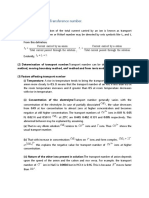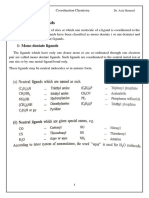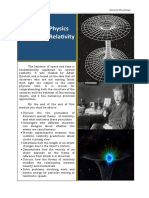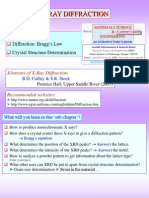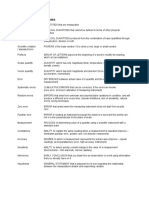X Class - SSC Andhra Pradesh Physics Differences Answers
X Class - SSC Andhra Pradesh Physics Differences Answers
Uploaded by
manawarangalCopyright:
Available Formats
X Class - SSC Andhra Pradesh Physics Differences Answers
X Class - SSC Andhra Pradesh Physics Differences Answers
Uploaded by
manawarangalOriginal Description:
Original Title
Copyright
Available Formats
Share this document
Did you find this document useful?
Is this content inappropriate?
Copyright:
Available Formats
X Class - SSC Andhra Pradesh Physics Differences Answers
X Class - SSC Andhra Pradesh Physics Differences Answers
Uploaded by
manawarangalCopyright:
Available Formats
7. LIGHT Give a comparison between Newtons corpuscular theory and Huygens wave theory.
(June 2008,April 2008,March 2005)
Newtons corpuscular theory of light 1 It assumes that light consists of a stream of extremely small particles called corpuscles. 2 The rectilinear propagation of light is explained by the straight line motion of corpuscles. 3 The colours of light are due to difference in the sizes of corpuscles. 4 The reflection and refraction of light are explained by the repulsion and attraction of the corpuscles by the medium. 5 It cannot explain the phenomena of interference, diffraction and polarization of light 6 It predicts that the velocity of light in a denser medium is greater than that in a rarer medium. Huygens wave theory of light 1 It assumes that light travels in the form of a wave.
2 The rectilinear propagation of light is explained by the advancement of wavefront along the direction of normals drawn to it. 3 The colours of light are due to differences in the wavelengths. 4 The reflection and refraction are explained by the construction of secondary wavefronts applying Huygens principle. 5 It can explain the phenomena of interference, diffraction and polarization of light. 6 It correctly proves that the velocity of light in a denser medium is less than that in a rarer medium.
8. MAGNETISM Explain the differences between Dia, Para and Ferro magnetic substances? (June-00,04,06,07) Magnetic materials can be grouped into three classes based on their important magnetic properties. They are 1) Dia magnetic substances, 2) Para magnetic substances, 3) Ferro magnetic substances. 1) Dia magnetic substances 2) Para magnetic substances: 3) Ferro magnetic substances:
Dia magnetic substances are those in which the resultant magnetic moment of individual atoms is zero. When a specimen of diamagnetic substance is brought near a magnetic pole of a bar magnet, it develops a similar or like pole and therefore it is repelled. The relative permeability (r ) is less than or equal to one (r 1) The magnetic susceptibility is small and negative. Examples are air, water, bismuth, gold, alcohol, mercury, hydrogen etc. Para magnetic substances are those in which the resultant magnetic moment of individual atoms is not zero. Ferro magnetic substances are those in which the resultant magnetic moments of individual atoms align themselves in parallel locally because of a special effect present in them giving rise to spontaneous magnetization. When a specimen of paramagnetic Ferromagnetic substances are strongly substance is brought near a pole of a attracted by magnets. bar magnet, it develops an opposite or unlike pole and therefore it is attracted. The relative permeability (r) is slightly greater than 1. (r >1) The magnetic susceptibility is small and positive. Examples are Oxygen, Solutions of salts of Nickel, and manganese, Aluminium, Platinum and chromium etc. The relative permeability (r) is greater than one. (r > > 1) The magnetic susceptibility is very high and positive. Examples are Fe, Co, Ni, Gadolinium(Gd), Dysprosium (Dy), etc.
2. OUR UNIVERSE
4.DYNAMICS Centripetal Force 1. The force which acts continuously on a particle initially moving with a linear velocity and makes it travel along a circular path. 2. It is always directed radially towards the centre of the circle. 3. It is magnitude F = mv2/r =mr2 4. It is associated with an external agent. Centrifugal Force 1. A radially outward force acting on a body in a uniform circular motion. Which is observed in an accelerated on rotating frame. 2. It is directed radially away from the centre of the circle. 3. It is magnitude is F =mv2/r = mr2 4. It can not be associated with any agent. 5. It is a fictitious force in an inertial frame of reference. 6. It is a tendency of the body to fly away from the centre of the circle. 7. It comes into play in a rotating from of reference. 8. In a uniform circular motion its magnitude is constant and equal to that of the centripetal force. 9. Centrifugal force depends on mass m. Hence bodies of higher mass rotate on a circle of higher radius.
5. It is real force in an inertial frame of reference. 6. It is a pull on the body towards the centre of the circle. 7. It is necessary to make a body to travel on a curved path. 8. In a uniform circular motion. Its magnitude is constant.
9. Centripetal force depends on a mass of a body in a circular motion with speed v.
Inertial Frame 1. An imaginary co-ordinate system which is at rest or in uniform motion. 2. Newton's Laws are valid. Rotatory Motion 1.The motion of a particle under the action of central force.
Non Inertial Frame 1. An imaginary co-ordinate system attached to an accelerated body. 2. Newton's Laws are not valid. Circular Motion 1.The motion of a body which has constant velocity but its direction changes keeping a fixed point. 2. Magnitudes of radius vector and linear velocity remains constant while direction alone changes. Eg: Motion of planet around themselves on their own axis.
2.Magnitude of a radius vector and linear velocity do not remains constant.
Eg: Motion of planets around the sun.
6. SOUND Progressive waves Stationary waves
1. These waves are produced by vibrating 1. These are formed when two waves of source and continuously travel forward in equal frequency and equal frequency and the medium. equal amplitude travel in opposite directions along the same path. 2. These waves travel in the form of crests 2. These waves are confined to a fixed and troughs through the medium in all region of the medium where they form node directions. and antinodes. 3. All the particles have same amplitude and frequency everywhere in the medium, Every particle undergoes the maximum displacement at one time or the other. 3. Amplitudes of different particles in the medium are different at different points. It varies from a minimum at nodes to a maximum at antinodes.
4. The phase of vibration changes far 4. The vibration of all the points within a different points along the wave at any loop are in phase and are out of phase with particular instant different respect to he points in the adjacent loop. particles have different phases. 5. Distance between successive crests or 5. Distance between successive nodes or troughs is antinodes /2 6. Energy is carried continuously by 6. Energy is trapped in a fixed region of forward moving waves through out the medium. medium
7. Every particle undergoes maximum 7. The particle at nodes undergo only displacement at one time or other. minimum displacement, while at antinodes they undergo only maximum displacement.
Transverse wave 1. Vibrations of particles of medium are at right angles to the direction of wave propagation. 2. A wave consist of a crest and trough.
longitudinal wave 1. Vibrations of particles of medium are parallel to the direction of wave propagation. 2. A wave consist of a compression and a rare fraction. 3. It does not exhibit polarisation. 4. The distance between two successive compression (or rarefaction) is equal to (wave length) 5. It can be produced in solid, liquids and gases.
3. It exhibits polarisation. 4. The distance between two successive crests (or troughs) is equal to (wave length) 5. It can be produced in solids and to little extent in liquid (water)
You might also like
- Worm and Worm WheelDocument2 pagesWorm and Worm Wheelzacoss70% (10)
- Sergio Pellegrino University of Cambridge, Cambridge, UK: Deployment. The Reverse Transformation Is Called RetractionDocument35 pagesSergio Pellegrino University of Cambridge, Cambridge, UK: Deployment. The Reverse Transformation Is Called RetractionRupesh DangolNo ratings yet
- Analysis of A Bucketwheel Stacker Reclaimer StructDocument9 pagesAnalysis of A Bucketwheel Stacker Reclaimer StructDevika SrivastavaNo ratings yet
- Atomic Structure Full Notes 50 PageDocument52 pagesAtomic Structure Full Notes 50 PageSubhajit GoraiNo ratings yet
- Atomic Structure and Spectra: Selection RulesDocument51 pagesAtomic Structure and Spectra: Selection RulesAdministracion OTIC IVICNo ratings yet
- CHM271 - Chapter 3 Ionic Equilibrium PDFDocument72 pagesCHM271 - Chapter 3 Ionic Equilibrium PDFMuhd AmirNo ratings yet
- Quantum MechanicsDocument29 pagesQuantum MechanicsHasan ZiauddinNo ratings yet
- CHM 112.introduction To Transition Metal ChemistryDocument27 pagesCHM 112.introduction To Transition Metal ChemistryCovenantNo ratings yet
- Electron Counting NotesDocument18 pagesElectron Counting Notesmissy.casanesNo ratings yet
- Quantum Solutions 2016Document3 pagesQuantum Solutions 2016JoanaNo ratings yet
- IAL Physics WavesDocument17 pagesIAL Physics Wavesvekariaraj99No ratings yet
- Sulphuric Acid NotesDocument1 pageSulphuric Acid Noteswen weiNo ratings yet
- Solvent Extraction LANTHANIDE SEPARATIONDocument4 pagesSolvent Extraction LANTHANIDE SEPARATIONGandiyaNo ratings yet
- New Modern PhysicsDocument3 pagesNew Modern PhysicsshabbirtechnicalNo ratings yet
- Surface Plasmon Resonance (SPR)Document11 pagesSurface Plasmon Resonance (SPR)Raj Kumar SoniNo ratings yet
- 7 - JEE - Chemistry - Electrochemistry - Transport Number or Transference NumberDocument2 pages7 - JEE - Chemistry - Electrochemistry - Transport Number or Transference NumberGurmehakdeep Billa100% (1)
- Endospore Lab Report - 2Document5 pagesEndospore Lab Report - 2api-487208181No ratings yet
- Photochemistry and Solar EnergyDocument28 pagesPhotochemistry and Solar EnergyNidharshananNo ratings yet
- Born-Haber CycleDocument21 pagesBorn-Haber CycleГульдана КуанткановнаNo ratings yet
- Unit - 1 Lesson - 1Document271 pagesUnit - 1 Lesson - 1Rakesh SharmaNo ratings yet
- Atomic Emission SpectrosDocument3 pagesAtomic Emission SpectrosRaj MalhotraNo ratings yet
- Textbook of Physical Chemistry, Second Edition by Moudgil, H. KDocument3 pagesTextbook of Physical Chemistry, Second Edition by Moudgil, H. KAanchal PathakNo ratings yet
- Lab 4: Extraction of Iodine From An Aqueous SolutionDocument4 pagesLab 4: Extraction of Iodine From An Aqueous SolutionWahyuAdhy100% (1)
- Unit Iv Photochemistry and Spectroscopy: Part A 1. Define PhotochemistryDocument18 pagesUnit Iv Photochemistry and Spectroscopy: Part A 1. Define PhotochemistryKrithigasri MurugesanNo ratings yet
- Absorption of Gamma Rays BZ 20151123Document8 pagesAbsorption of Gamma Rays BZ 20151123salmanNo ratings yet
- CHAPTER-chemwiki Mossbauer SpectrosDocument8 pagesCHAPTER-chemwiki Mossbauer SpectrosAparna PrasadNo ratings yet
- Magnetic Properties and ParamagnetismDocument20 pagesMagnetic Properties and Paramagnetismnkar0370% (1)
- Spectral Calculation of Orgel and Tanabe-Sugano Diagram'SDocument18 pagesSpectral Calculation of Orgel and Tanabe-Sugano Diagram'STiwari VishalNo ratings yet
- Classification of LigandsDocument9 pagesClassification of LigandsNorbert TongeraiNo ratings yet
- Electrochemical Cell SLDocument27 pagesElectrochemical Cell SLRyan BoukaaNo ratings yet
- CMO 88 S. 2017 BS Electrical EngineeringDocument112 pagesCMO 88 S. 2017 BS Electrical EngineeringEstelita BantolinoNo ratings yet
- Lambert-Beer's LawDocument1 pageLambert-Beer's LawRAGHAV SHARMANo ratings yet
- Born Solvation - From CherieDocument7 pagesBorn Solvation - From CherieNandika Kasaru JackNo ratings yet
- Chem 11 Unit 7 PPT 1 HebdenDocument27 pagesChem 11 Unit 7 PPT 1 HebdenMarina XuNo ratings yet
- Nuclear Chemistry: Unit 11Document15 pagesNuclear Chemistry: Unit 11Suryansh SrivastavaNo ratings yet
- Electron & Neutron DiffractionDocument24 pagesElectron & Neutron Diffractionzeex60No ratings yet
- Bioelectrochemistry: Name: Pranay A Shinde STD: MSC Part 1 ROLL NO: 120 Sub Teacher: Harshada Mam (Physical Chem)Document17 pagesBioelectrochemistry: Name: Pranay A Shinde STD: MSC Part 1 ROLL NO: 120 Sub Teacher: Harshada Mam (Physical Chem)JVM. 13 Pranay ShindeNo ratings yet
- Forensic Mid-Semester Short Answer Practice Questions AnswersDocument11 pagesForensic Mid-Semester Short Answer Practice Questions AnswersHenry SimpsonNo ratings yet
- Ir SpectraDocument38 pagesIr Spectra21AIB316 ABHINAV GUPTANo ratings yet
- 4.1 MIS and NJS Manual For Inorganic Semi-Micro Qualitative Analysis PDFDocument17 pages4.1 MIS and NJS Manual For Inorganic Semi-Micro Qualitative Analysis PDFShivam MeraviNo ratings yet
- Modern Physics ModuleDocument111 pagesModern Physics ModuleMichael EsmallaNo ratings yet
- D and F BlockDocument15 pagesD and F Blockthinkiit100% (1)
- Theoryofirspectroscopy 160622080111Document50 pagesTheoryofirspectroscopy 160622080111ArshNo ratings yet
- Iit Jam Booklet A ChemistryDocument8 pagesIit Jam Booklet A ChemistryAmarnathNo ratings yet
- 02 AssignmentDocument38 pages02 AssignmentRUSHIKESH ZADENo ratings yet
- ChromatographyDocument18 pagesChromatographyyoga nayagi punichelvanaNo ratings yet
- 1st Year Chemistry Chapter 2Document3 pages1st Year Chemistry Chapter 2Zeeshan ahmedNo ratings yet
- Malik Xufyan-Only Chemistry DiscussionDocument1 pageMalik Xufyan-Only Chemistry DiscussionHermanNo ratings yet
- Class 11 Chemistry Revision Notes Chemical Bonding and Molecular StructureDocument26 pagesClass 11 Chemistry Revision Notes Chemical Bonding and Molecular Structureshusa harshaNo ratings yet
- ST01502 Earth Science (Sains Bumi)Document22 pagesST01502 Earth Science (Sains Bumi)Moganambal RavichandranNo ratings yet
- PolarographyDocument2 pagesPolarographySean Collins67% (3)
- Time Dependent Schrodinger EquationDocument26 pagesTime Dependent Schrodinger EquationLearning Scholar100% (1)
- Introduction To Inorganic PhotochemistrypdfDocument6 pagesIntroduction To Inorganic Photochemistrypdfjayaprabha KNNo ratings yet
- 15.law of Equipartition of EnergyDocument4 pages15.law of Equipartition of EnergyVarun dhawanNo ratings yet
- Important Terms: Quantitative AnalysisDocument6 pagesImportant Terms: Quantitative Analysisqasim khokhar100% (1)
- Spontaneity of Redox ReactionsDocument21 pagesSpontaneity of Redox Reactionssaeikip0% (1)
- Magnetism SC L1-3Document24 pagesMagnetism SC L1-3Abhishek tiwariNo ratings yet
- Chapter 3c X Ray DiffractionDocument48 pagesChapter 3c X Ray DiffractionAnup Dalal100% (1)
- Under The Greenwood TreeDocument2 pagesUnder The Greenwood TreeDash Hunter83% (12)
- CBSE Class 12 Chemistry - Solid State AssignmentDocument13 pagesCBSE Class 12 Chemistry - Solid State AssignmentAbhi RajNo ratings yet
- Unit IV IR SpectroscoptyDocument37 pagesUnit IV IR SpectroscoptyNTGNo ratings yet
- Interaction Formulae For Members Subjected To Bending and Axial Compression in EC3-Method 2 Approach-Greiner-JCSRDocument14 pagesInteraction Formulae For Members Subjected To Bending and Axial Compression in EC3-Method 2 Approach-Greiner-JCSRkostas formulagrNo ratings yet
- JUPEB Physics syllabusNGDocument27 pagesJUPEB Physics syllabusNGbalikisyakubu64No ratings yet
- Understanding RF Experiment 2Document6 pagesUnderstanding RF Experiment 2Harold Fabian Bonilla RestrepoNo ratings yet
- Non-Linear Seismic Soil Structure Interaction Method For Developing Nonlinear Seismic SSI Analysis Techniques - 1Document20 pagesNon-Linear Seismic Soil Structure Interaction Method For Developing Nonlinear Seismic SSI Analysis Techniques - 1atman chanaNo ratings yet
- Refrigeration and Air ConditioningDocument76 pagesRefrigeration and Air Conditioningmat_pran100% (3)
- Che424 Note 6Document46 pagesChe424 Note 6AnuragNo ratings yet
- Oxygen Diffusion in Pores of Iron-Ore PelletsDocument3 pagesOxygen Diffusion in Pores of Iron-Ore PelletsKrol PrietoNo ratings yet
- Young's Modulus (Modulus of Elasticity) - E - Ultimate Tensile Strength - S Yield Strength - SDocument6 pagesYoung's Modulus (Modulus of Elasticity) - E - Ultimate Tensile Strength - S Yield Strength - Skiran_wakchaureNo ratings yet
- Physics Terms & DefinitionDocument11 pagesPhysics Terms & DefinitionSniper Grenade100% (1)
- Lecture 5Document46 pagesLecture 5ζοβαγεπ ἯοΣΣαῖηNo ratings yet
- Projectile Motion: Engr. Cynthia V Plaza InstructorDocument21 pagesProjectile Motion: Engr. Cynthia V Plaza InstructorCynthia PlazaNo ratings yet
- Ricoh MP 301 Parts CatalogueDocument102 pagesRicoh MP 301 Parts Cataloguevestaricoh scannerNo ratings yet
- Developments in Elastic StructuresDocument3 pagesDevelopments in Elastic StructurespraveennagarajanNo ratings yet
- SVT Collge of Engg. Structure II Lecture Notes..1245Document38 pagesSVT Collge of Engg. Structure II Lecture Notes..1245Shams KhattakNo ratings yet
- Dynamic Analysis of Wind Turbines Including Soil-Structure InteractionDocument10 pagesDynamic Analysis of Wind Turbines Including Soil-Structure InteractionsuzanavilaNo ratings yet
- WaveIntroductionWaveTypesWaveFrequency PDFDocument4 pagesWaveIntroductionWaveTypesWaveFrequency PDFmary ann espinaNo ratings yet
- Isolated Footing For PedestalDocument3 pagesIsolated Footing For Pedestalkushaljp8989No ratings yet
- Pipe Stress Engineering (PDFDrive) 6Document1 pagePipe Stress Engineering (PDFDrive) 6Darshan PanchalNo ratings yet
- Eerc 07 01Document73 pagesEerc 07 01Hugo BobadillaNo ratings yet
- Transport Mechanics: A. Reynolds Number C. Mach NumberDocument22 pagesTransport Mechanics: A. Reynolds Number C. Mach Numberjerome deiparineNo ratings yet
- Finite Element Considerations Mat FoundionDocument7 pagesFinite Element Considerations Mat FoundionAhmed Al-Amri100% (1)
- Honors Physics Goals v2Document15 pagesHonors Physics Goals v2saevans18No ratings yet
- Lesson Plan - Momentum (Grade 9)Document4 pagesLesson Plan - Momentum (Grade 9)Cherry GonzalezNo ratings yet
- Robotics SyllabusDocument2 pagesRobotics SyllabusKetan Deokar100% (1)
- Cbfc16d0cc5b9e8091aeaea1e26NSEP 2023 Question PapeRDocument16 pagesCbfc16d0cc5b9e8091aeaea1e26NSEP 2023 Question PapeRhowsonoobNo ratings yet
- Mixing & Agitation 2022Document83 pagesMixing & Agitation 2022Rahul PatelNo ratings yet
- Derek J. Raine, Edwin George Thomas - Black Holes - A Student Text-Imperial College Press (2015) PDFDocument299 pagesDerek J. Raine, Edwin George Thomas - Black Holes - A Student Text-Imperial College Press (2015) PDFvanloc85No ratings yet















